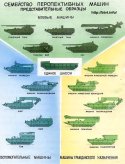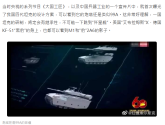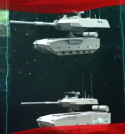APS while not the perfect solution is still better than a cope cage, and you need a clear line of sight for APS to work.Its not a proper upgrade unless it also incorporates cope cage as an integral element of the tank. Any Tank without a cope cage is no longer relevant for the modern battlefield. But most tanks have these cages as a tack-on instead of integral design elements.
You are using an out of date browser. It may not display this or other websites correctly.
You should upgrade or use an alternative browser.
You should upgrade or use an alternative browser.
PLA Next Generation Main Battle Tank
- Thread starter by78
- Start date
You need a awfull lot of shot on that APS to be relevant against drones presently. We have seen how multiple cheap drones can harass mbt now. We have seen mbt got hit more than 10 times with fpv drones in minutes in Ukraine. Beside direct hits, you get your sensors pelleted from above with small drops.APS while not the perfect solution is still better than a cope cage, and you need a clear line of sight for APS to work.
You will be empty of APS in not time if you rely only on that.
APS will certainly be part of a protection system that will have some gun to help it counter small drones at longer range, a bit like the RCW Natter or ACS bullfrog. China have certainly an equivalent in their hands or in development.
Last edited:
From my admittedly limited understanding, developing a dedicated anti-drone weapon station isn’t particularly difficult. The real issue isn’t just suicide FPV drones—it’s the sheer density of UAVs saturating the battlefield, allowing any strike asset to rapidly engage. Even if you can counter drones, you’d still need to pile on more armor.
The Type 99 upgrade might adopt a combo of weapon stations + heavy armor + ESM/ECM suites, with firepower taking a backseat. The Russia-Ukraine war has pretty much proven that’s the direction things are headed.
The Type 99 upgrade might adopt a combo of weapon stations + heavy armor + ESM/ECM suites, with firepower taking a backseat. The Russia-Ukraine war has pretty much proven that’s the direction things are headed.
Ultimately although better designs and extra horsepower may improve mobility, in many terrains operating ultra heavy vehicles is just straight up impossible. No matter how advanced technology gets, the same watery beach or muddy slog does not suddenly get extra supportive strength to keep you from sinking in. In WW2 the black panthers weighing 45tons mobilized well with many terrains but Tigers at 55tons often get stuck in mud. Tiger 2 weighing close to 70 tons breaks the ground wherever it goes.
AFV mobility is quite often misunderstood.
First up, the Panthers (Pz.Kpfw. V), Tiger I (Pz.Kpfw. VI Ausf. E) and Tiger II (Pz.Kpfw. Tiger Ausf. B) ALL had good floatation or soft ground mobility.
The Tiger II didn't break ground wherever it went - no more so than the Panther or Tiger I did as they all had similar suspension design and similar gross metrics on various aspects of ground pressure. All 3 tanks actually travelled well over soft/muddy terrain but did often get "stuck" in mud because they all used interleaved road wheels which were susceptible to being "stuck" together if the mud hardened or froze them together.
To understand this, consider first that the average tracked vehicles, despite being significantly heavier than wheeled vehicles, are often viewed as having better cross-country mobility than wheeled vehicles. This cannot be if tracked vehicles often "break the ground" and become immobilised by virtue of weight alone. Weight is one of the factors but is not the determinant here.
Ground pressure (GP) is often used as a rule of thumb mechanic in that weight of the vehicle is divided by the contact patch on the ground which determines how much pressure is being exerted on the ground. Take an example of a human standing on deep snow and sinking into it. Same human, weight remains same but now with snow shoes. Contact patch has now enlarged so weight per cm2 is now reduced and said human stays "afloat" on top of same patch of snow. Same principle applies to vehicles.
MMP or Mean Maximal Pressure or VCI (Vehicle Cone Index) is a slightly more complicated measure of ground pressure. The basic of this is that pressure along the track is not evenly distributed (which GP assumes). There are peaks that exceed nominal GP due to the contact between the tank and it's tracks being via the road wheels. The bigger the contact patch between road wheels and track, the more evenly distributed the GP and the lower the MMP. Logically, to achieve maximum contact and lowest possible MMP, you need lots of small wheels (think caterpillar tracks or Churchill Tank). However, small wheels are bad at high speed. For high speed, you need bigger wheels but bigger wheels means smaller contact patch, leading to higher MMP which means that section of the track breaks through the ground "crust" causing the rest of the track to start sinking into the terrain. Hence the German design of interleaved road wheels for the Big Cat series of tanks. Same example of human, this time lady in stiletto heels. Standing still, GP is divided across the heel and ball of the shoe. But walking, when the stiletto strikes the ground, before the rest of the foot does, the weight is exerted over that little point. So MMP here is waaaay higher than the Nominal GP.
To summarise, weight alone is not a determinant in the tactical mobility of a vehicle and how it will perform in soft ground. There are tracked mining vehicles at 10,000+ tons. Design of vehicle suspension and trafficability of ground (single pass vs multi pass) can totally change the picture.
Weight though is a very big factor in the strategic mobility of vehicles (within operational context). As has been often pointed out, the ability of the road infrastructure (primarily bridges) to accommodate repeated traffic from 30 ton and 70+ ton vehicles is vastly different. If a bridge can only take 30 tons, your formation of 70+ tons MBT is going to come to a grinding halt. Which is why you see so much emphasis on bridging assets in armoured formations.
Another less limiting factor is size of vehicle. Width is a factor that also affects strategic mobility (ex-theatre) in that some vehicles are too wide to rail transport (eg, the Tigers both had specific narrower tracks to fit within the max width of rail transport) and therefore move long distances. Width can also affect tactical mobility as some vehicles are also specifically designed narrower to fit within certain specific quirks of their AO (or even bridging assets).
To gloss over the "mobility" of a MBT by just looking at their gross weight is just wrong.
Last edited:
Yeah in general the ground pressure of tanks is usually not that bad because it is spread out over a much larger surface than 4 wheels. It's usually the strategic mobility aspect where weight causes problems.
This is a big reason why Soviet/Russian tanks are designed with lower weights, they insisted on the ability to traverse their own bridges which they knew could not withstand the 60-70 ton Western designs.
Weight though is a very big factor in the strategic mobility of vehicles (within operational context). As has been often pointed out, the ability of the road infrastructure (primarily bridges) to accommodate repeated traffic from 30 ton and 70+ ton vehicles is vastly different. If a bridge can only take 30 tons, your formation of 70+ tons MBT is going to come to a grinding halt. Which is why you see so much emphasis on bridging assets in armoured formations.
This is a big reason why Soviet/Russian tanks are designed with lower weights, they insisted on the ability to traverse their own bridges which they knew could not withstand the 60-70 ton Western designs.
There is no reason to deny the fact that credible PLA watchers have said the heavy version of this vehicle(Not sure if referring to the armor kit or a unseen modification) has been cancelled and that there is a new heavy tank under development. Heavy tanks(~50 tons) do still have their place for siege and urban warfare post landing for expeditionary warfare as well as protecting the northen border with Russia. Also the original US FCS program never intended to field a proper MBT but instead a light tank/assault gun variant. What is slightly more similar would be the Soviet Object 299 and other vehicles associated with it, it was actually intended to produce a MBT although highly unconventional in design along with basically everything else with a universal hull.I´ve been following this program (and thread) at least since 2019, I´ve never seen any indication that the Chinese might be working on a different heavier tank platform.What we did see are some test rigs (super early BTW) with 7 road wheels. But everything else, interviews with people involved in the program, etc. points to the need for the lighter platform we ended up seeing in prototype form. In other words, the PLAA estimates its going to be conducting mostly expeditionary warfare going forward. With that strategic forecast, a heavier tank makes a lot less sense. Though I don´t doubt for a second that the Chinese can develop and adopt whatever they fancy at a rate no one else can do nowadays.
As for the lighter tank, we´ve seen prototypes "naked" and also in uparmored configuration.
View attachment 156895
In addition, other new tracked AFV prototypes we´ve been seeing recently appear to be based on the same basic hull. Having a universal 30-40 ton platform that is cuting edge in every way is very reminiscing of the vision US had for the Future Combat Systems program from more than 20 years ago, but ended up being succesful.


"所以好消息是这车的重型版本非常不意外的被砍了。重型车有重型车的未来,我国幅员辽阔,一支百万人的陆军需要4-5种坦克,这并不奇怪,其中不差一个双离谱" -Ayi
Ayi is saying the heavy armor version of this vehicle got cancelled and is hinting at a new heavy tank
Ayi also hinted at PLAGF might ditch the MBT concept of producing a single vehicle that could do everything and start going for specialised tanks for specific combat roles/conditions. So potentially this 40 ton vehicle would be replacing Type 96 and older tanks in service while Type 99As would be replaced by another heavy MBT.
Last edited:
This is not true. The FCS was to phase out the totality of AFV platforms for the US Army in favor of net centric (this was absolutly science fiction back then) light platforms that could be airlifted anywhere in the globe, as the US Military thought that no serious competition to them would ever rise up and the most dangerous enemies to fight against were to be armed at most by export soviet tanks.Also the original US FCS program never intended to field a proper MBT but instead a light tank/assault gun variant.
I don´t think the 99A are going away anytime soon, most likely they will be further upgraded for some years to come. However when you think about it strategically, those are the tanks that are least likely to be used in real combat by the PLA. Their most likely war scenarios by far are tone ones this "light MBT" is ideal for."所以好消息是这车的重型版本非常不意外的被砍了。重型车有重型车的未来,我国幅员辽阔,一支百万人的陆军需要4-5种坦克,这并不奇怪,其中不差一个双离谱" -Ayi
Ayi also hinted at PLAGF might ditch the MBT concept of producing a single vehicle that could do everything and start going for specialised tanks for specific combat roles/conditions. So potentially this 40 ton vehicle would be replacing Type 96 and older tanks in service while Type 99As would be replaced by another heavy MBT.
99A Fulfill that role perfectly nowadays, and its unlikely Russia will ever place actual worrying tank units on the Chinese border. Actually, the strategic alliance between Russia and China allow them to scale down their military deployments at their shared borders significantly and focus their military posture against their actual enemies. Russia will have most of its armed forces facing west while China will have them facing east. So, developing a whole new 55ish ton tank just for Russia is absurdly wasteful. A few further modernized Type 99 will more than suffice to face a similarly low number of T-72s.Heavy tanks(~50 tons) do still have their place for siege and urban warfare post landing for expeditionary warfare as well as protect the northen border with Russia.
This is evidentally not going to be true for China as it will face off against possible heavily armored western tank for expeditionary warfare hence requiring advance capabilities. Plus what you said and what I said isn't in conflict as I said the FCS was never meant to produce a true MBT(Abrams successor) because as you said the US army didn't think there would be any future threats.This is not true. The FCS was to phase out the totality of AFV platforms for the US Army in favor of net centric (this was absolutly science fiction back then) light platforms that could be airlifted anywhere in the globe, as the US Military thought that no serious competition to them would ever rise up and the most dangerous enemies to fight against were to be armed at most by export soviet tanks.
Type 99A is a design stemming from the weaker technological ages of China, no matter how people like to say it is highly modified and "westernised" compared to the original Type 99. It still uses old soviet AZ autoloader with no thought given to modern drone warfare and urban warfare. Also as I said advanced armor is still required to hold chokepoints and speerhead assaults etc even for expeditionary warfare which the 99A no longer suffices for. In fact I believe most equipment stemming from the age of "小步快跑" or catching up to western standards should be phased out of service or moved to second/third/training duty as soon as convenient. As the PLA is currently both financially and technologically capable of producing top of the line AFVs even compared to top western counterparts and hence should do so(as they are rumored to be doing already).I don´t think the 99A are going away anytime soon, most likely they will be further upgraded for some years to come. However when you think about it strategically, those are the tanks that are least likely to be used in real combat by the PLA. Their most likely war scenarios by far are tone ones this "light MBT" is ideal for.
tl;dr I believe 99A is a product from a time where Chinese technological prowess have not reached world class level yet and hence not suitable for further major modifications due to compromises taken with the design.


